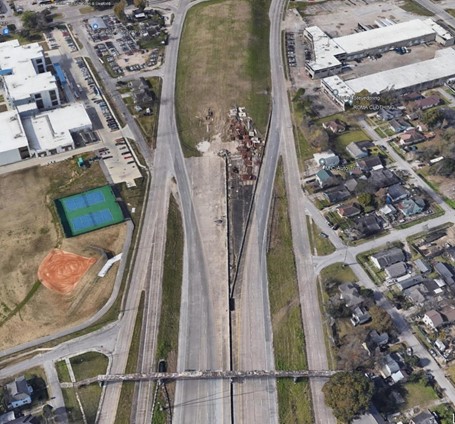I remember thinking “this is an unusual place” as I drove down a sparsely-populated-for-rush-hour stretch of Leeland past the Oak Farms plant to visit my then-boyfriend at his Eastwood bungalow over ten years ago. The sproutings of town home farms transitioned to skeletal remains of warehouses, which gave way to cute 1930s bungalows, some impeccably maintained and others showing their mileage. Well, the East End stuck, and so did the boyfriend, who is now the father of my baby boy. After reading my colleague Mark Merrell’s reflections on Houston’s relentless westward expansion, I started reflecting on my ten years on the side of town that was arguably left behind and is now a hotbed of all issues urban renewal.
The biggest potential impact to the east side of town is TxDOT’s proposed North Houston Highway Improvement Project, which would scrap the Pierce Street Elevated in favor of rerouting I-45 where Chartres Street currently sits. The entire block of businesses between Chartres and St. Emanuel would be levelled. Had TxDOT acted twenty years earlier, this right-of-way acquisition would have been significantly less costly and would not have put business owners in the position where they simply cannot replace the properties that they face losing in the East End. Should this segment of I-45 move forward, these business owners will have no choice but to relocate to a different part of Houston, and the East End will pay the price.
This is not the first time a highway has threatened the East End. Taking SH 225 in from the Loop is a singularly perplexing experience to a newbie, and as usual with real estate, when something seems odd, there’s a story. In the 1960s, the City sought to alleviate congestion on the Gulf Freeway by extending SH 225 along Harrisburg to downtown, in what would be called the Harrisburg Freeway. TxDOT accepted the proposed freeway into its highway system in 1969. Due to community opposition and the TxDOT budgetary crisis in the ‘70s, the proposed freeway spent a few years in design limbo and was never revived. The proposed highway was eliminated from the City of Houston’s throughfare map in the 1990s. Will the North Houston Highway Improvement Project meet the same fate as the Harrisburg Freeway? Some of the same ingredients are there, but only time will tell.

While the big question remains unanswered, smaller changes are already coming to the neighborhood thoroughfares in the East End. Using federal dollars earmarked for alternate modes of transportation, the City is implementing “road diets” on a number of local streets. In a road diet, a roadway with excess capacity is repurposed within the boundaries of its right-of-way to improve safety and provide space for other modes of transit. A road diet has been implemented on parts of Lawndale, and Telephone Road is slated to follow. The goals that these projects seek to achieve are laudable, and the problems identified are real. The sidewalks in these areas are in poor condition, at grade with the roadway, and there is very little building setback to provide a buffer from motor vehicles. By adding in bike lanes, ADA compliant sidewalks, and esplanades, the government is essentially building on public property the very landscaping features that our landowner clients often have taken from them on their private property through incremental road-widening acquisitions. A landscaping easement in a commercial development is not there by accident or because the developer had extra space; the value that the City hopes to add via road diets is the same thing that a property owner loses when its landscaping areas are taken. But, by adding in these features at the expense of current motor vehicle right of way, instead of in addition to the existing lanes, the City may be creating a smaller scale I-45 problem. Given the growth on the East Side, at some point the leaner roads will not be enough to handle the volume of traffic, and then the City will have a very expensive and disruptive choice to make.

